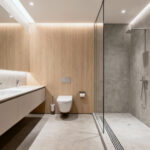To design a home is, in its essence, an act of self-discovery—every choice reflects not just aesthetic preference, but deeper beliefs about how life should be lived and felt. The most compelling dining spaces I’ve encountered aren’t simply decorated; they are authored. They tell a coherent story about their inhabitants’ connections, values, and understanding of nourishment’s role in daily life. These twenty principles separate a room that feels truly authentic from one that just looks composed.
This is a journey from the abstract philosophy that underpins a nourishing space to its tangible application. We’ll move through four stages, beginning with the foundational intention of your dining room and exploring how to manifest it through material choices and spatial arrangements. Our goal is to create a dining room layout that becomes an integrated part of your wellness—a sanctuary where every element contributes to harmony, connection, and a deep sense of joy. Let’s begin.
Foundational Philosophy: Architecting Intentionality and Well-being (Part 1)
Before we place a single chair, we must understand the soul of the space. A dining room is far more than a place to eat; it is a modern hearth, a stage for connection, sustenance, and reflection. This first section explores the foundational intentions that transform a collection of furniture into a sanctuary that nurtures both body and spirit.
1. Prioritizing Intentionality: Cultivating a Purposeful Dining Sanctuary
The first and most critical step is to ask: what is the deep purpose of this space for you? Beyond eating, what do you want to feel here? Connection? Calm? Creative energy? A sanctuary is born from this kind of unwavering intentionality. When you lead with intention, the room stops being a default space and becomes a deliberate stage for mindful nourishment and reflection.

Every material choice should then flow from this core purpose. If your intention is grounding and long conversations, a solid, reclaimed wood table with its inherent story and warmth is a natural fit. If your focus is on clarity and minimalism, you might choose sleek, simple surfaces. This isn’t just about looks; it’s about how a space feels to the touch and how it supports your desired energy. A dining room layout guided by intention makes these decisions feel intuitive and right.
2. Embracing Biophilic Integration: Nurturing Connection with Natural Elements Through Layout
As humans, we have an innate need to connect with the natural world—a principle we call biophilia. Bringing nature into your dining space isn’t just a trend; it’s a powerful tool for wellness, proven to reduce stress and enhance our sense of vitality. This can be as simple as a collection of potted plants or as foundational as the materials you choose.
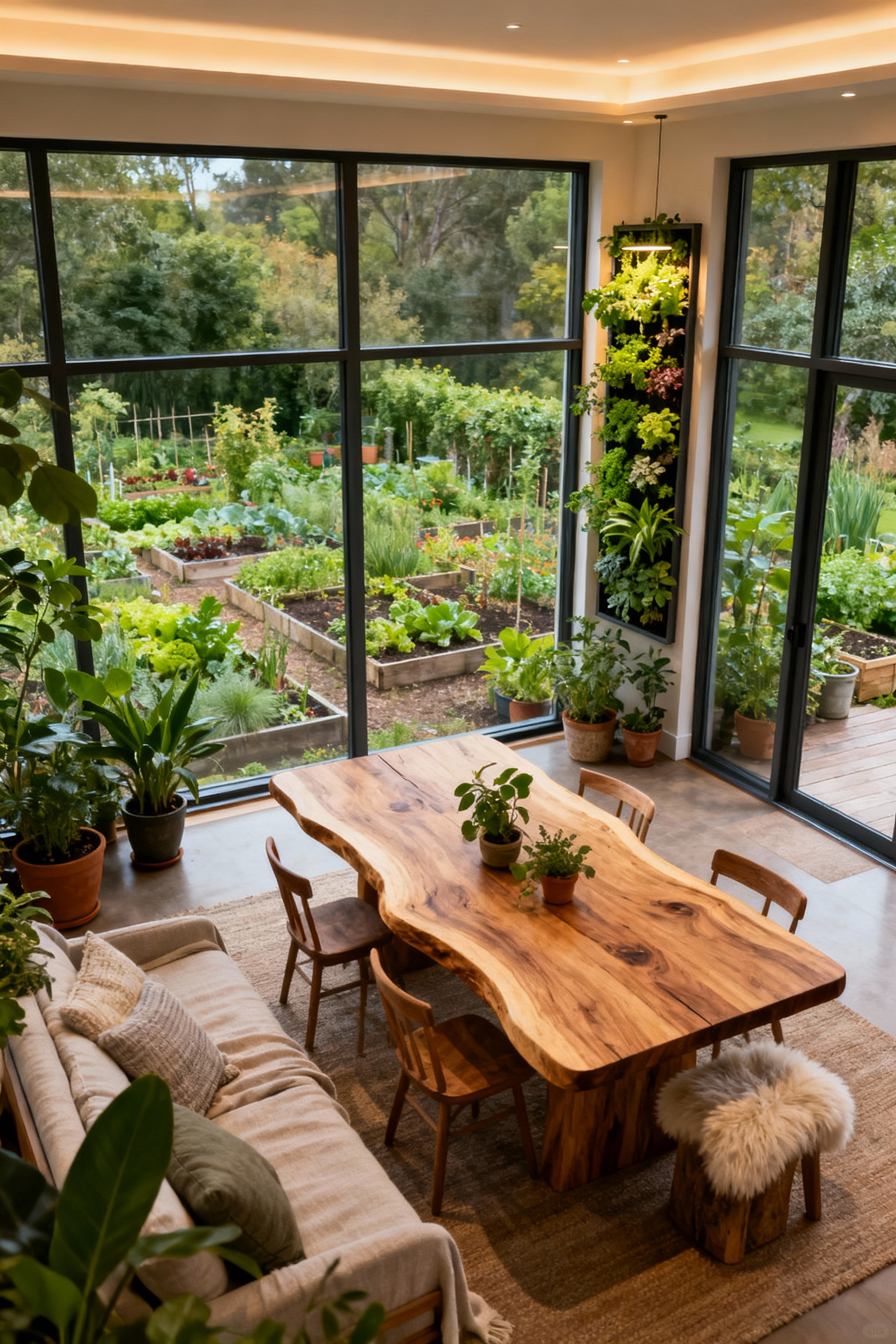
Think about a dining table made from live-edge wood, where the natural form of the tree is celebrated. Or stone flooring that feels grounding underfoot. Maximize the natural light you have, orienting your table to capture a view of the garden or a tree outside. Even in an urban apartment, a small indoor herb garden on a windowsill can provide a living, fragrant connection to nature that deeply enriches the experience of a meal.
3. Decoding Energetic Flow: Optimizing Qi Circulation for Gastronomic Well-being
Rooted in Eastern philosophy, the concept of Qi, or vital energy, teaches us that the way energy moves through a room affects our well-being. A dining space with good energy flow feels instinctively comfortable and supports not just good conversation but good digestion. The goal is to create a dining room layout where this energy can circulate freely, without becoming stagnant or chaotic.

This means ensuring there are clear, unobstructed pathways for movement. A table shouldn’t feel crammed into a corner, nor should it be directly in line with a busy doorway, which can make the space feel unsettled. In my wellness design consultant practice, I’ve noticed that one of the most impactful adjustments is ensuring the person who often hosts has a solid wall behind their back, which provides a subconscious feeling of support and stability.
4. Curating Sensory Congruence: Harmonizing Visual, Tactile, and Auditory Dimensions within the Plan
Our experience of a room is a rich symphony of the senses. A truly harmonious dining space considers not just how it looks, but how it feels and sounds. This principle, sensory congruence, is about orchestrating these elements so they tell a consistent story of comfort and presence.

Visually, this means a color palette that supports appetite and calm, and lighting that can be adjusted for mood. Tactilely, it’s the feel of a smooth tabletop, soft linen napkins, and comfortable upholstery. And just as important is the auditory experience. Soft materials—like rugs, drapery, and upholstered chairs—absorb sound, preventing the harsh echoes that can make conversation feel strained and overwhelming.
Foundational Philosophy: Architecting Intentionality and Well-being (Part 2)
Building upon this initial groundwork, we deepen our inquiry. The following principles explore how strategic design choices can cultivate a dining environment that is not just well-appointed but truly resonant with the rhythms of daily life and human connection.
5. Defining the Communal Core: Strategic Placement for Enhanced Interaction and Connection
Before you even consider furniture, consider the dining room’s role as the communal heart of your home. Its location within your home’s overall floor plan is a powerful statement about its importance. A dining space that is centrally located and easily accessible becomes a natural gathering point, inviting spontaneous connection.

The “material” here isn’t wood or stone, but the relationship between spaces. Does your dining area flow easily from the kitchen, encouraging a seamless connection between cooking and serving? Or is it adjacent to a living space, allowing conversation to spill over after a meal? Your dining room layout should support these transitions, creating intuitive, graceful pathways that draw people together.
Experiential Landscape: Orchestrating Form, Light, and Sound (Part 1)
With our philosophical foundation in place, we now turn to the tangible elements that shape our experience. Light, form, and sound are the true architects of atmosphere. This section explores how to wield these tools with intention, creating a rich sensory landscape for every meal.
6. Optimizing Illuminative Stratification: Orchestrating Layered Lighting for Ambiance and Functionality
Light is the single most powerful tool for shaping the mood of a room. Rather than relying on one harsh overhead source, think of light in layers: ambient, task, and accent. Ambient light provides the overall glow—think of a chandelier or recessed lighting. Task lighting is focused, like a pendant over the table that illuminates your meal. Accent lighting, like a picture light or sconce, adds depth and highlights beauty.
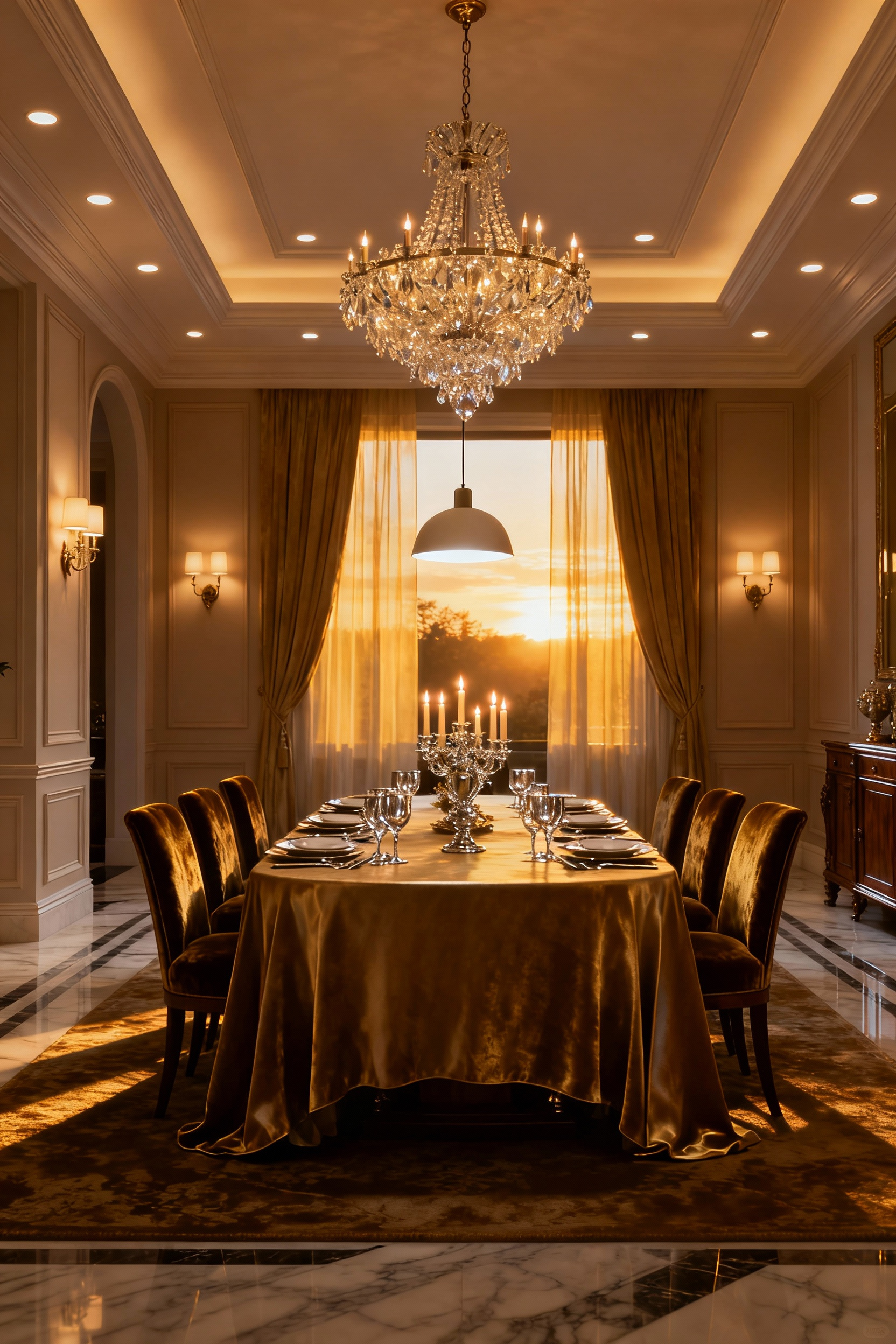
A well-designed dining room layout incorporates all three. The key is control. A dimmer switch on your main light source is non-negotiable; it allows you to shift the atmosphere from a bright family breakfast to a soft, intimate dinner. This layering gives the space a beautiful, dynamic quality that can adapt to any occasion.
7. Specifying Ergonomic Proportions: Ensuring Seating Comfort and Dynamic Movement Clearance
A beautiful dining room is worthless if it’s uncomfortable. Ergonomics—the science of designing for human comfort—is essential. This means choosing chairs with proper support and ensuring the height relationship between your chairs and table allows for relaxed dining (typically 11-12 inches between the seat and the tabletop).
Just as critical is the space around the furniture. You need at least 36 inches—ideally more—between the edge of the table and the nearest wall or obstruction. This allows people to pull out their chairs and move around the table without feeling trapped. This thoughtful clearance is a quiet form of hospitality, making everyone feel more at ease.
8. Incorporating Acoustic Attenuation: Designing for Serene Conversational Dynamics and Reverberation Control
What I tell my clients is that acoustics are the invisible architecture of a room. In a dining space with too many hard surfaces—wood floors, bare windows, a glass table—sound bounces around, forcing everyone to raise their voices. This creates a subtle but constant level of stress.

You can soften the sound, and the mood, by incorporating absorptive materials into your dining room layout. A plush area rug under the table makes a huge difference. Upholstered chairs, heavy drapes, or even a large textile wall hanging can all help absorb sound, creating a calmer, more intimate atmosphere where conversation can flow effortlessly.
9. Employing Volumetric Balance: Harmonizing Furniture Mass with Spatial Constraints to Prevent Overcrowding
Volumetric balance is about the relationship between the “stuff” in a room and the empty space around it. A room feels right when the furniture’s scale and visual weight are in harmony with the room’s proportions. A massive, dark wood table might overwhelm a small room, while a delicate, leggy one could feel lost in a grand space.

Before you buy, measure your room and your furniture. Pay attention to “negative space”—the empty areas are just as important as the occupied ones. The goal is to create a sense of breathability. Your dining room layout should feel neither empty nor cluttered, but purposefully composed, allowing the eye and the spirit to rest.
Experiential Landscape: Orchestrating Form, Light, and Sound (Part 2)
We continue our orchestration of the dining experience by examining how supporting elements and sightlines contribute to the room’s overall sense of harmony. These details, though seemingly minor, are pivotal in creating a cohesive and effortless environment.
10. Integrating Functional Juxtaposition: Positioning Ancillary Elements for Seamless Service and Aesthetic Harmony
Sideboards, buffets, and bar carts are the unsung heroes of the dining room. They shouldn’t be afterthoughts but integral parts of the room’s choreography. Their purpose is to provide seamless support to the dining ritual, keeping everything you need within easy reach but out of the way.
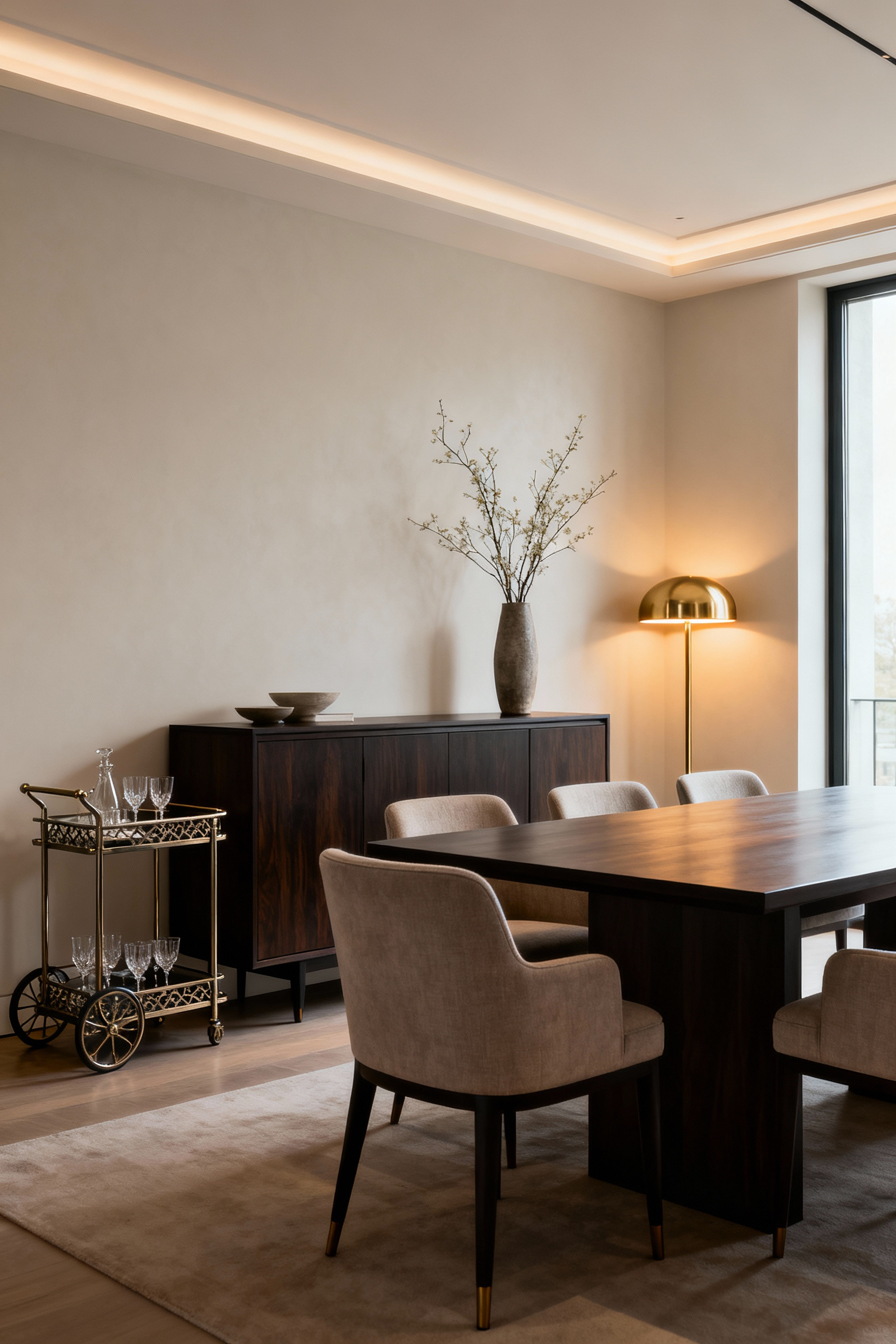
The key is proximity without obstruction. A buffet should be close enough to the table for easy serving but placed so it doesn’t create a traffic jam. In a small space, a narrow console table might be all you need. The dining room layout should feel like a graceful dance, where every piece plays a supportive role in creating an effortless experience for both host and guest.
Spatial Applications: Architectural Realizations and Dynamic Configurations (Part 1)
Now we translate our intentions and sensory plans into the physical reality of the room. This is where we shape the space itself, using layout strategies to create definition, flow, and a profound sense of architectural rightness.
11. Delineating Zonal Integrity: Establishing Clear Boundaries within Open-Plan Schemas for Defined Spaces
In an open-plan home, creating a distinct “zone” for dining is crucial. Without clear boundaries, the dining area can feel like a transitional hallway rather than a destination. This delineation doesn’t require walls; it can be achieved with subtle but powerful visual cues that signal a shift in purpose.
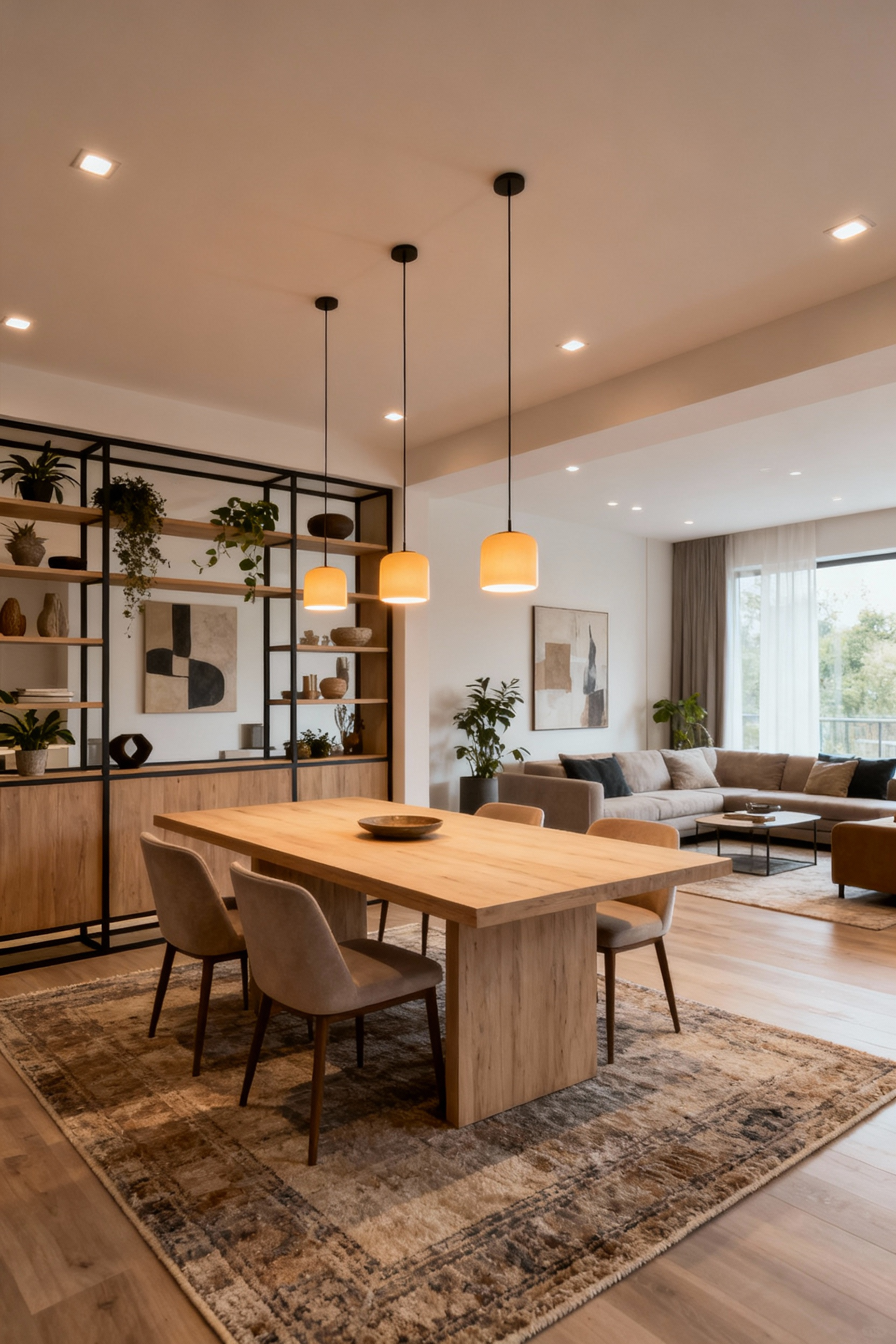
A large area rug is the simplest and most effective way to anchor your dining room layout, creating a “room within a room.” Its edges should extend at least 24 inches beyond the table on all sides, so chairs remain on the rug even when pulled out. A dramatic pendant light hung low over the table or a deliberate change in wall color can also create a powerful sense of place, helping to focus energy and attention on the act of dining together.
12. Mastering Traffic Path Permeability: Ensuring Unobstructed Circulation Pathways Around the Dining Zone
A space that flows well feels good. It’s that simple. One of the most common design mistakes I see is creating a dining room layout that obstructs the natural pathways of movement in a home. Constant squeezing past chairs or bumping into corners creates tiny moments of friction that add up to a feeling of unease.

Years of professional experience taught me that people feel an immediate sense of relief when circulation is clear, even before new furniture or decor is introduced. Map out the primary traffic routes—from the kitchen to the table, from the dining room to the outdoors—and keep them clear. This ensures the room functions with a quiet grace that supports, rather than hinders, daily life.
13. Implementing Geometric Affinity: Selecting Table Shapes Complementary to Room Form and Traffic Flow
The shape of your dining table has a profound impact on both the feeling and function of the room. A table shape that works in harmony with the room’s geometry creates a sense of effortless balance. It’s about a conversation between the furniture and the architecture.
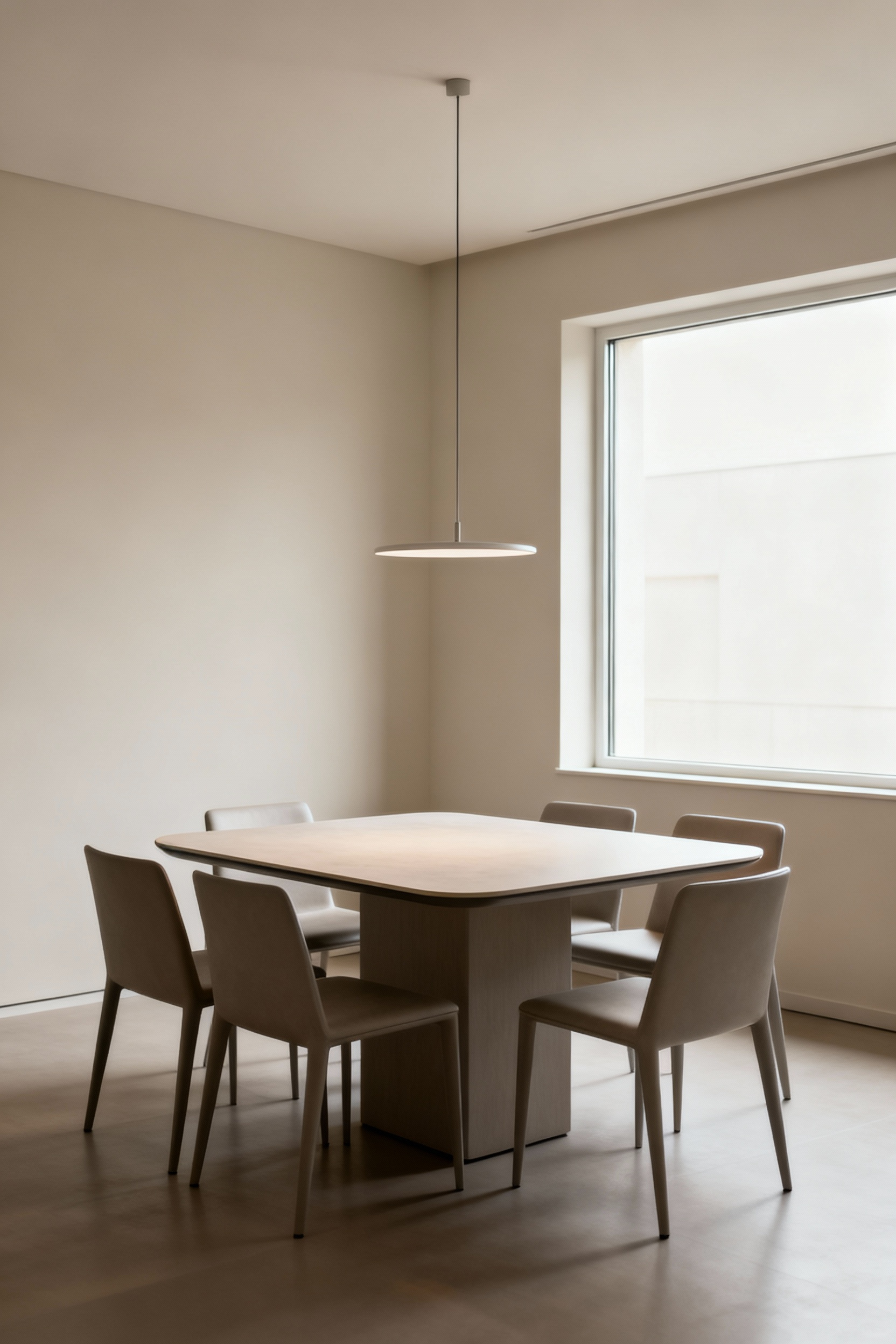
A long, rectangular room naturally calls for a rectangular or oval table. A square room often feels most balanced with a square or round table at its center. Round tables are wonderful for fostering intimate, egalitarian conversation where everyone can see and hear each other easily. They also lack sharp corners, making them a great choice for tighter spaces or homes with small children.
14. Activating Axial Alignment: Orienting Furnishings for Visual Gravitas and Enhanced Room Perspective
Our eyes crave order and a clear focal point. Axial alignment is about using the room’s architecture—a large window, a fireplace, a doorway—to create a strong visual axis and then aligning your primary furniture along it. This gives the space a sense of stability and intention.

Positioning your dining table to align with the room’s most prominent feature immediately gives your dining room layout a powerful, grounded presence. A buffet centered on the opposite wall reinforces this line, creating a pleasing symmetry. This isn’t about rigid formality; it’s about creating a visual order that is calming to the brain and deeply satisfying to the eye.
Spatial Applications: Architectural Realizations and Dynamic Configurations (Part 2)
Building upon the structure of alignment and flow, we now explore more dynamic compositional strategies. This is where we can play with balance and perception to create a dining space that feels both harmonious and uniquely captivating.
15. Exploiting Asymmetric Balance: Creating Dynamic Visual Interest Through Non-Mirroring yet Harmonious Arrangements
While symmetry is calm and predictable, asymmetric balance can be far more interesting and dynamic. This is the art of achieving equilibrium using objects of different visual weights. It’s not about perfect mirroring but about a felt sense of balance. A heavy sideboard on one wall can be balanced by a grouping of lighter-weight art on the opposite wall.
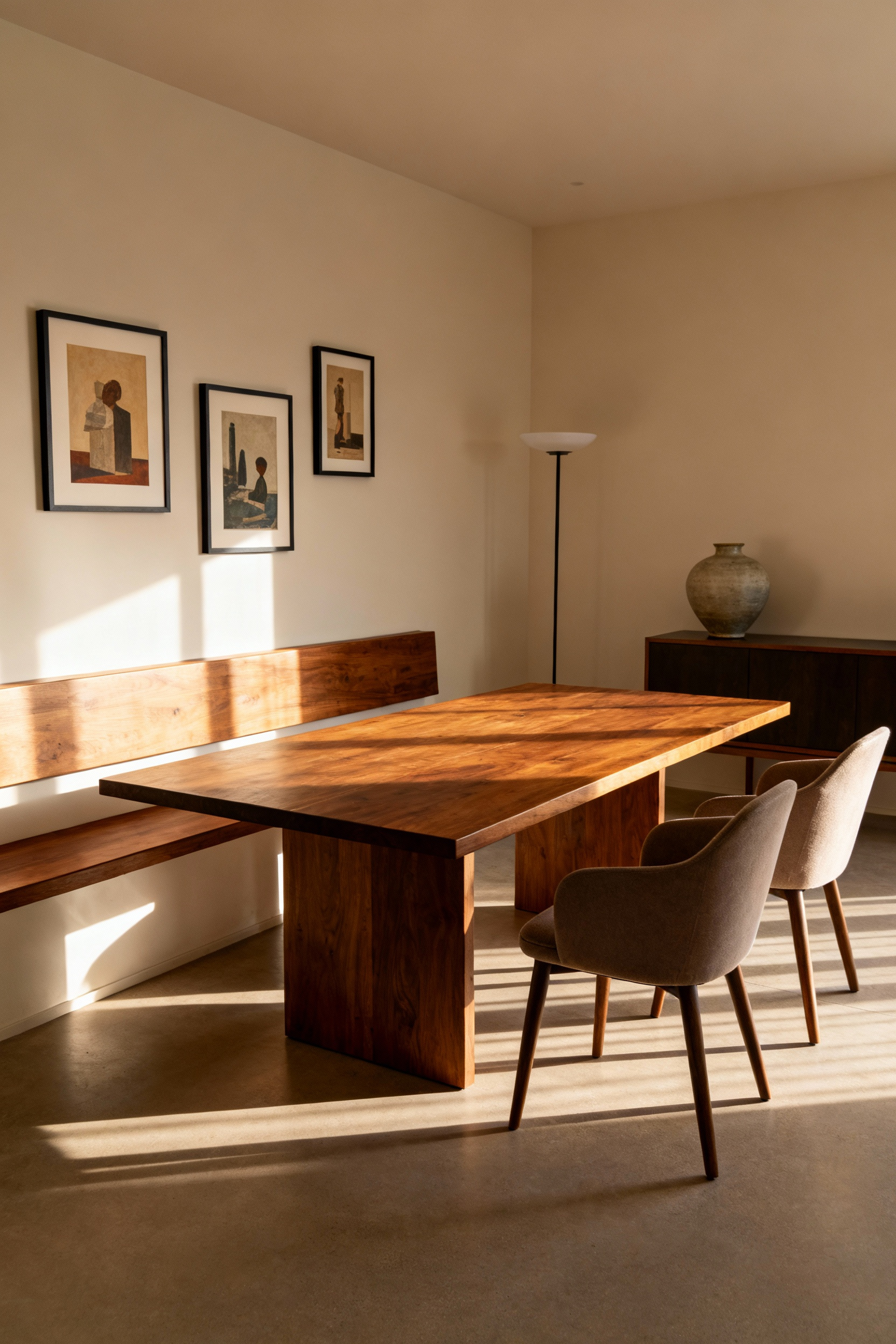
This approach brings a wonderful, organic energy to a dining room layout. It feels less staged and more authentically curated over time. Try offsetting a pendant light over one end of your table, and balancing it with a tall plant in the opposite corner. This creates a visual tension that is sophisticated and engaging, drawing the eye around the room.
Lifestyle Integration: Adaptive Frameworks for Evolving Wellness (Part 1)
A home should be a partner in our lives, adapting and evolving with us. A truly successful design looks beyond the present moment. This section focuses on creating a dining room layout that is flexible, resilient, and prepared to support your well-being through every stage of life.
16. Cultivating Multi-Functional Adaptability: Designing for Dynamic Use-Case Scenarios Beyond Traditional Dining
Today’s dining room is rarely just for dining. It’s a home office, a craft station, a homework hub, and a place for game nights. A wellness-focused dining room layout embraces this reality, building in adaptability from the start.
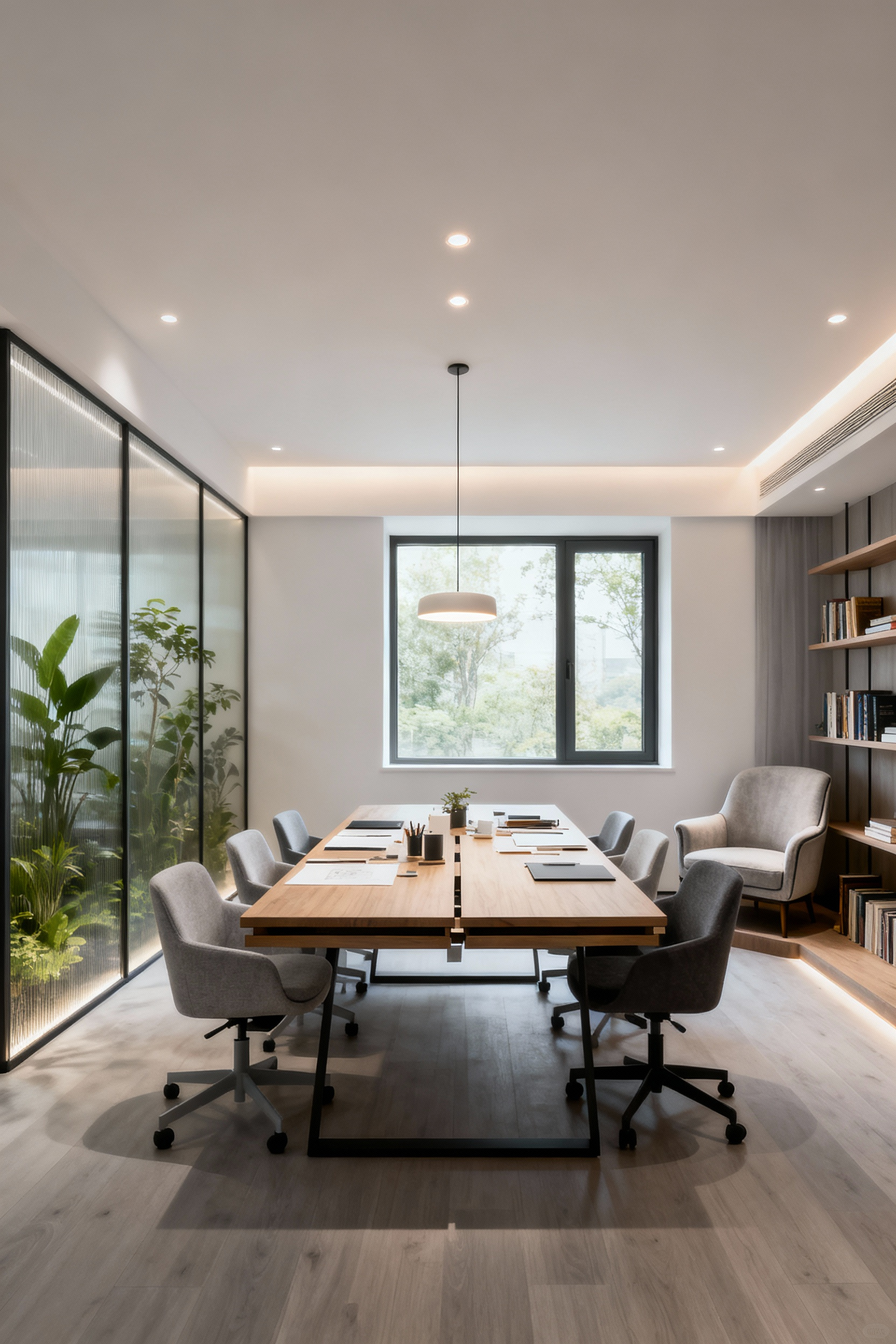
This could mean choosing an extendable table that can shrink for daily use and grow for gatherings. A durable, easily-cleaned tabletop material is a must. And think about storage: a beautiful credenza can hide away laptops and art supplies when it’s time to set the table for dinner. A room that can gracefully shift functions reduces stress and makes the home work harder for you.
17. Anticipating Experiential Scaffolding: Layouts for Both Intimate Gatherings and Grand Celebrations
A great dining room layout should feel just as comfortable for a quiet dinner for two as it does for a boisterous holiday feast. This is what I call “experiential scaffolding”—designing a framework that can support a full spectrum of social experiences.
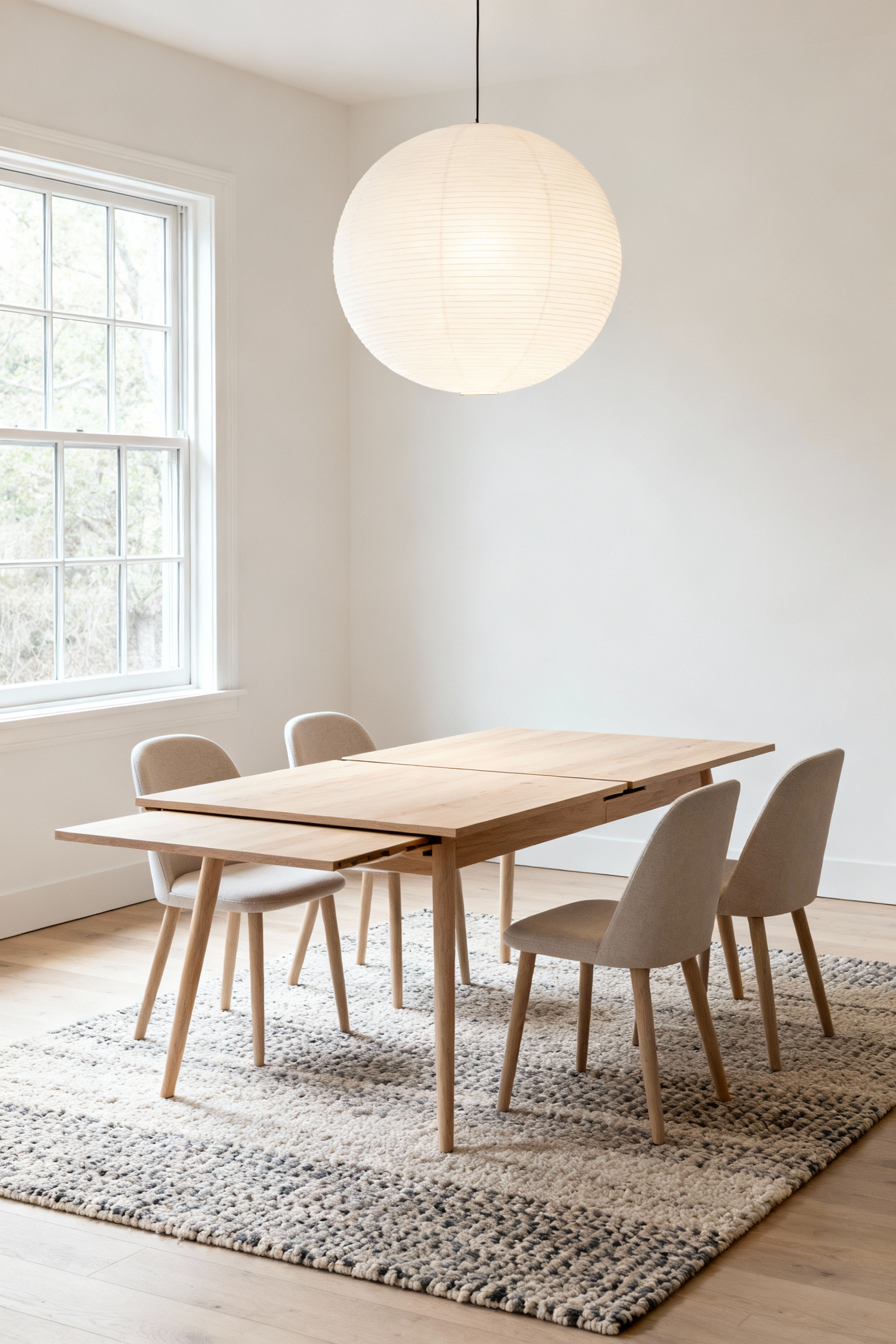
An expandable table is key, but so is the surrounding space. Can you easily bring in extra chairs without creating a logjam? Is there a surface that can double as a buffet for serving? Using layered, dimmable lighting helps immensely here, allowing you to make a large room feel cozy or a small room feel festive.
18. Avoiding Layout Logjams: Identifying and Rectifying Common Spatial Bottlenecks and Obstructions
We’ve touched on traffic flow, but it’s worth a deeper look. A “layout logjam” is any point of friction in the room—a chair that always blocks a doorway, a rug that’s too small and trips people up, a sideboard that makes a walkway too narrow. These small, daily annoyances disrupt the calm of a home.

Take an honest look at your dining room layout. Walk the paths you use most often. Is there anywhere you consistently have to squeeze by? Sometimes a simple fix—like rotating the table 90 degrees or choosing chairs that tuck fully underneath—can completely transform the feel and function of the space, creating a sense of effortless ease.
19. Prioritizing Future-Proofed Resilience: Accommodating Life-Stage Transitions with Foresight in Design
Designing with foresight means creating a space that can grow with you. What will your family’s needs be in five years? In twenty? This isn’t about predicting the future, but about making choices that allow for flexibility.

This might mean ensuring pathways are wide enough to one day accommodate a walker or choosing timeless, durable materials that will withstand the wear and tear of young children and still look beautiful in an empty nest. From my work in mindful space planning, I’ve seen that when a home can adapt with a family, it fosters a deeper sense of security and belonging. This is the essence of a resilient, lifelong home.
Lifestyle Integration: Adaptive Frameworks for Evolving Wellness (Part 2)
We conclude our journey by focusing on the most personal aspect of design: infusing your space with your own unique story. This final principle ensures that your dining room is not just a well-designed space, but a true reflection of you.
20. Personalizing Epistemological Resonance: Infusing the Space with Authentic Narrative and Meaning Through Layout Choices
This may sound academic, but it’s deeply personal. It means designing a space that reflects your authentic story, your values, and your cherished memories. It’s the difference between a showroom and a soul-filled home. Your dining room should be a testament to what nourishment means to you—in every sense of the word.
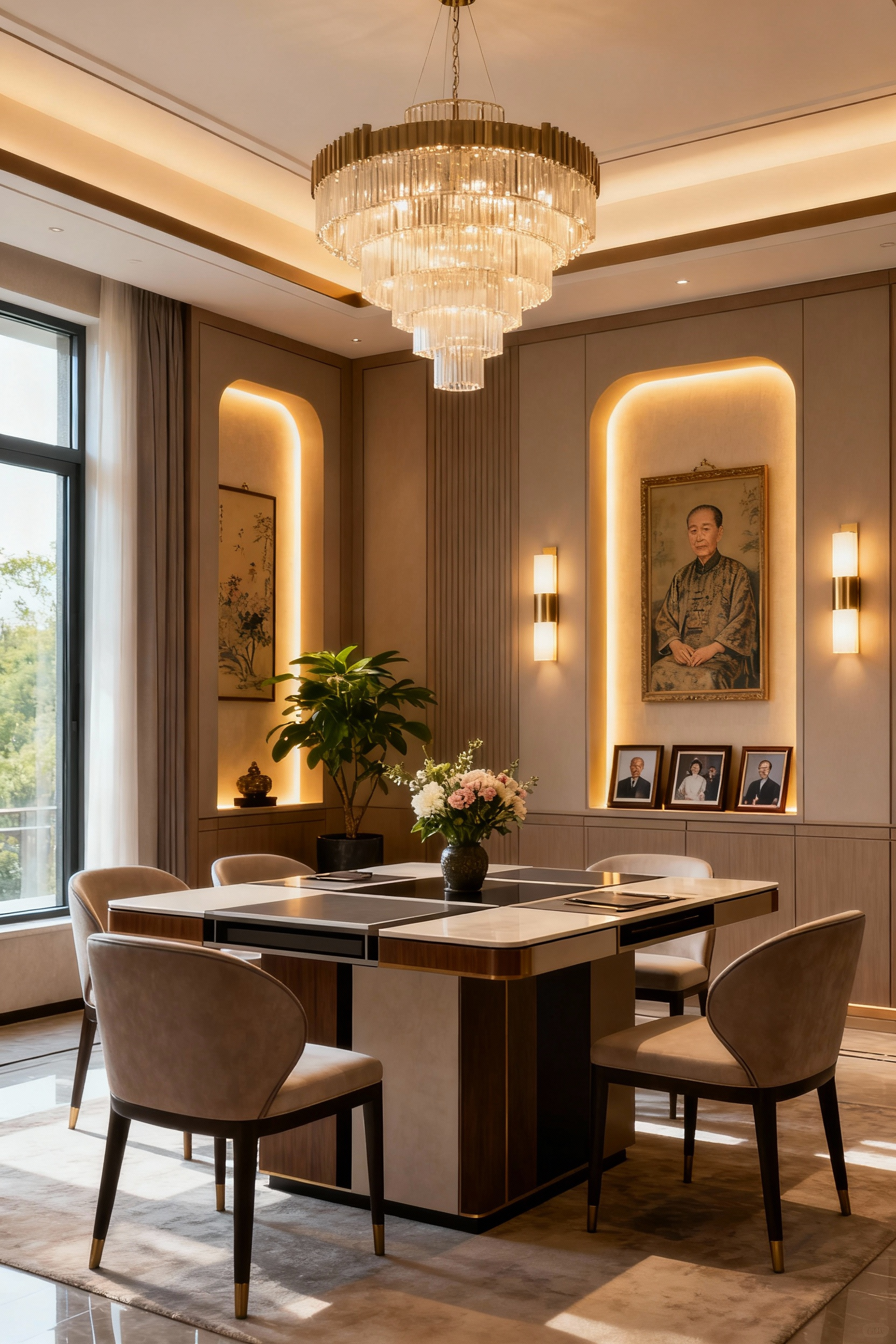
Let your dining room layout tell your story. Make room for the antique cabinet passed down from your grandmother. Display the art you collected on a meaningful trip. Choose textiles that remind you of a place you love. When your surroundings resonate with your personal narrative, your home becomes a true sanctuary—a space that not only looks right but feels profoundly, authentically yours.
Conclusion
As we conclude these twenty principles, it’s clear that crafting a dining room layout is far more than an exercise in arranging furniture. It is a thoughtful act of creating a sanctuary—a space designed to foster connection, nourish well-being, and hold the memories that shape our lives. We have moved from foundational philosophy to the practical realities of light, form, and flow, understanding that each element is part of a larger, interconnected whole.
The true goal is not to create a perfect room, but a resonant one. It’s about creating a space that feels like a deep exhale, where conversation flows easily and every meal feels like a small celebration of life. I encourage you to use these principles not as strict rules, but as gentle guides. Approach your dining space with fresh eyes and a clear intention. Because when you create a room that is aligned with your values, you are doing more than decorating—you are cultivating a deeper, more joyful quality of life.


